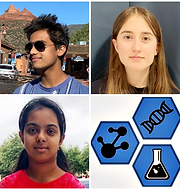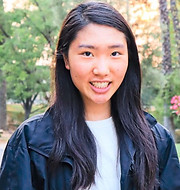
JOIN US
Past Spring & Summer 2022 Colloquia
Summer 2022 Colloquia Dates:
-
June 7 Guest Speaker Carissa Dunn, Ph.D, 14, 21, 28
-
July 5, 12, 19, 26
-
August 2, 9, 16, 24 (Aug 24 7-9pm are the Summer 2022 Virtual Blitz Talks)
Spring 2022 Colloquia Dates:
-
January 11, 18, 25
-
February 1, 8, 15, 22
-
March 1, 8, 15 Guest Speaker Dr. Lucas, 22, 29
-
April 5 Guest Speaker Dr. Valentine, 12 (cancelled), 19, 26 (Advisor Open House)
-
May 3, 10, 17, 24
Watch it again! Watch prior Colloquia on the ASDRP YouTube Channel.
Weekly - Every Tuesday
7:00 - 8:30 PM (Pacific Time)
Join the Colloquia
Tuesday, August 16, 2022
Department of Chemistry, Biochemistry, and Physics
Development of next-generation prodrugging strategies - molecular solutions to clinical problems.
The toxicity of small molecule drugs employed in chemotherapy introduces a myriad of risks that pose harm to the long term health of patients. Side effects such as hair loss, internal bleeding and even loss of appetite can all be attributed to the off target toxicity of chemo agents. In light of this, researchers have studied prodrugs and biomolecule drug conjugates in hopes to alleviate such symptoms. One type of biomolecule drug conjugate are antibody drug conjugates (ADC's). Antibody-drug conjugates (ADCs), a novel class of immunotherapeutics, have gained traction due to their highly specific delivery of cytotoxic payloads to tumor sites. Utilizing routes developed by Michel et. al (2020), our lab synthesized SN-38 drug conjugates and attached them to multiple antibodies for in-vitro testing. In addition, photorelease has shown immense potential due to its increased bio-orthogonality and ease of control. Using a novel two-step synthetic route, our lab developed three photoreleasble prodrugs of Podophyllotoxin.

Researcher: Tyler D., Dougherty Valley High School '23
Advisor: Njoo, Organic Chemistry
Keywords: Organic Chemistry | Reaction Methodology | Chemical Biology | Physical Chemistry || Medicinal Chemistry | Spectroscopy | Therapeutics | Drug Discovery and Development | Antibody-Drug Conjugates | Cancer
Tuesday, August 16, 2022
Department of Biological, Human, & Life Sciences
Development of synthetic aptamers for use as low-cost PLD1 inhibitors.
PLD1 is a gene in the genome of a cell that codes for an enzyme also called PLD1. The PLD1 gene is sometimes overexpressed in a cell through mutations or extra signaling to the cell. This gene then codes for a protein, specifically an enzyme. This enzyme breaks down a chemical called phosphatidylcholine into 2 other chemicals: phosphatidic acid, and choline. The phosphatidic acid then leaves the cell and attaches to any mTOR receptor in another cell and causes a signal to be sent into the cell. By signal transduction and a phosphorylation cascade the cell starts performing mitosis. In excess amounts of phosphatidic acid the mTOR receptor can constantly signal to the cell to start mitosis in which case cancerlike properties can emerge from that cell. PLD1 amplifies anti-apoptotic functions that cause inflammation and creates a roadblock for chemotherapy. Many patients redirect treatment to immunotherapy, which is more expensive than chemotherapy. The focus of our project is to create synthetic aptamers using specialized DNA or RNA bases to act as competitive inhibitors for PLD1 allowing patients to continue chemotherapy.

Researchers: Anushka S., Mission San Jose High School '24; Dhruv P., Milpitas High School '23; Elora D., Washington High School '23
Advisor: Amadi, Biotechnology and Synthetic biology
Keywords: Synthetic Biology l PLD1 l Competitive Inhibitor l Biotechnology
Tuesday, August 16, 2022
Department of Computer Science & Engineering
Quantum computing and quantum chemistry updates - atomic and molecular Gaussian-orbital Hartree-Fock energy calculations and quantum-classical generative adversarial network for molecular geometry generation.
Current material science, pharmaceutical, and organic chemistry compound synthesis reaction pathway determination has been implemented with various computational chemistry methods. However, in light of the increasing necessity of precision, accuracy, and resource use efficiency, methodological improvements must be instituted. The presentation will detail the implementation of molecular geometry generation processes through hybrid quantum-classical generative adversarial networks, as well as efficient STO-nG basis set Hartree-Fock approximations of the Schrodinger equation for atomic and molecular energy calculations. Furthermore, we will cover updates on the research and pending publications of the quantum computing and quantum chemistry groups, and planned future work through a qGAN/Hartree-Fock molecule geometry and orbital energy calculation system to improve on classical GAN/density functional theory systems currently in use.

Researchers: Vaibhav V., The Quarry Lane School '23; Adelina C., Archbishop Mitty High School '24; Max C., Sir Winston Churchill Secondary School, '24
Advisor: McMahan, Computer Science & Quantum Computing
Keywords: Quantum Computing | Quantum Chemistry | qGAN | Hartree-Fock | Molecule Building
Tuesday, August 9, 2022
Department of Chemistry, Biochemistry, and Physics
Practical Synthesis of Novel Fluorinated Antivirals for the treatment of HIV/AIDs and COVID-19.
For the past half century, organofluorine therapeutics have been attracting attention due to fluorine’s metabolic stability and ability to alter polarization and thus lipophilicity. Certain commercially available antivirals, such as efavirenz, an NNRTI for the treatment of HIV/AIDs, and carmofur, a human acid ceramidase inhibitor which has been found to be an inhibitor of SARS-CoV-2 Mpro in a drug repurposing study, are such antivirals that make use of these properties of fluorine. Here, we investigated the synthesis and computational screening of analogs of efavirenz as well as synthesis of analogs of carmofur enabled by benchtop 19F NMR. The results presented herein will enable the future discovery and development of small molecule antivirals against a broad spectrum of clinical targets.

Researcher: Kavya P., Lynbrook High School '23
Advisor: Njoo, Organic Chemistry
Keywords: Medicinal Chemistry | Antivirals | SARS-CoV-2 | HIV/AIDs | NNRTIs | NMR Spectroscopy | Fluorinated Compounds
Tuesday, August 2, 2022
Department of Biological, Human, & Life Sciences
Application of Topological Data Analysis on Neurodegenerative Disease and Genomics.
Topological methods to extract information from data are gaining in popularity for analyzing large genomic data sets. Topological Data Analysis (TDA) is a field that utilizes algebraic topology and computational geometry to provide insight into the underlying shape and structure of data. Applications to cancer research and analysis of diseases have demonstrated the value of using TDA to identify significant patterns and genetic markers. Our research focuses on the genomics of neurodegenerative disease, and we are using TDA to analyze genomic data to better understand how neurodegenerative diseases manifest. TDA algorithms such as Mapper, we are using visualization methods to analyze the structure of genomic data. Our research has significant implications on the medical field, as identifying indicators of neurodegenerative disease can revolutionize treatment and diagnosis.
.png)
Researchers: Krishnaveni P., '24, BASIS Independent Silicon Valley, Sathya P., BASIS Chandler, '23, Aparna B., '24, Notre Dame San Jose, Deniz Y., Palo Alto High School '24
Advisor: Jahanikia, Life Sciences, Neuroimaging, Psychology & Bioinformatics
Keywords: Neuroscience | Data Science | Topological Data Analysis | Neurodegenerative Disease | Genomics
Tuesday, August 2, 2022
Department of Biological, Human, & Life Sciences
Exploration of Functional Fixedness and Creativity Through the Development and Administration of Creativity Tasks.
Functional fixedness is known to limit divergent thinking, a key component in a person’s creativity level. Our project aims to understand how functional fixedness affects human creativity through the development and administration of original creativity tasks based on existing tasks (i.e. AUT, RAT, etc.).

Researchers: Nicole J., Aragon High School '24, Rishabh B., Homestead High School '24, Pranjal B., Irvington High School '23
Advisor: Jahanikia, Life Sciences, Neuroimaging, Psychology & Bioinformatics
Keywords: social psychology | creativity | functional fixedness | divergent thinking
Tuesday, July 26, 2022
Department of Computer Science & Engineering
Analysis of the Voynich Manuscript and Its Connections to the Silk Road.
The Voynich Manuscript is a mysterious codex thought to originate in the 15th century, written in an unknown character set (known as Voynichese). The manuscript contains multiple drawings that resemble plants, herbs, and astrological charts. Many researchers throughout history have attempted to decipher the Voynich Manuscript’s contents, with little success. This has generated a wide range of controversy over the manuscript's discussion. In this presentation, we explore a variety of methods to uncover the manuscript's origin and meaning, from applying natural language processing on the source character set to examining its physical composition and finding connections to the Silk Road.

Researchers: Alexander Lau, San Jose High School '24
Advisor: Downing, Data Science, Machine Learning, Astronomy
Keywords: Voynich Manuscript | Silk Road | natural language processing | computer science | cryptography | linguistics
Tuesday, July 19, 2022
Department of Computer Science & Engineering
The Performance of Concrete Containing Various Supplementary Cementitious Materials in Carbon Sequestration.
Concrete is the second most used material on earth after water. The main constituent of concrete is cement. Cement is essential for constructing any nation’s infrastructure, such as roads and bridges. However, the cement industry is responsible for a considerable share of the total anthropogenic CO2 emissions, about 8%. Therefore, sustainability has become a vital goal of the construction industry.
Several approaches have been adopted to ensure the sustainability of concrete, the most common of which has been partially replacing cement with supplementary cementitious materials (SCM). SCMs are mostly industrial byproducts, especially those with high silica and alumina content, such as fly ash. Those elements react with the cement hydration products and contribute further to the strength and durability of concrete. The construction industry has recently moved toward building materials that can absorb carbon from the atmosphere reducing CO2 concentrations. This characteristic can render a building or a material carbon neutral (if not negative) over its service life. Several methods can facilitate carbon sequestering; mineral carbonation has been the most successful. In this method, the carbon from the atmosphere reacts with elements in the material. It then becomes chemically bound in cement concrete (primarily mineral carbonate). This work summarizes our knowledge of the various supplementary cementitious materials used as a cement replacement and how the resulting concrete performed as a carbon sink.

Researchers: Wesley C., American High School '23; Angel S., Miss Porter’s School ' 24; Max P., BASIS Independent '24
Advisor: Amer, Civil Engineering & Environmental Engineering
Keywords: Civil Engineering | Carbon Sequestration | Ground Glass Fibers | Slag
Tuesday, July 19, 2022
Department of Chemistry, Biochemistry, and Physics
Drug discovery campaigns require the ability to quantitatively determine cellular responses.
The outcome of drug discovery campaigns requires the ability to quantitatively determine cellular responses to the administration of a compound. For this reason, various biochemical assays have been developed that give optical readouts for cellular viability. One such assay relies on the reduction of tetrazolium salts, such as 5-diphenyl tetrazolium bromide (MTT) by intracellular oxido-reductase enzymes to their formizan counterparts which, being brightly colored, provide an optical readout for the redox activity in living cells. However, the assay assumes that participation of MTT in non-cellular redox reactions is negligible; interference in the assay from media components that react with MTT has created challenges in data reproducibility and assay standardization. Here, common reducing agents were screened to identify the extent to which and the mechanism by which they cause interference in cell-free MTT autoreduction. The use of the MTT assay was then used to quantify the biological potential of monastrol and andrographolide, as well as their analogs, in order to determine their in-vitro cytotoxicity.

Researchers: Kara T., Dublin High School '23
Advisor: Njoo, Organic Chemistry
Keywords: Drug Discovery | Tetrazolium Bromide | Redox Activity | Monastrol | Adrographolida
Tuesday, July 19, 2022
Department of Biological, Human, & Life Sciences
Studying the Impact of the COVID-19 Pandemic on the Behavioral Plasticity of Adolescents.
Cognitive dissonance theory states that when one’s attitude conflicts with their behavior, a discomfort arises in the brain; this discomfort is known as cognitive dissonance. The goal of our study is to collect information on the dissonance that high school students have experienced over the course of the COVID-19 pandemic and to truly understand the correlation between the effect of the pandemic and dissonant feelings teenagers have recently experienced. We hypothesized that new and constantly changing legislation concerning vaccines, masks, public safety, and school regulations have led to students experiencing cognitive dissonance. As of now, we have 32 participants and 49 consenting parents. Overall, participants have experienced mild dissonance; lowest dissonance was found in the vaccines group (statements regarding COVID-19 vaccines) and highest dissonance was found in the government/authority group (statements regarding government/authority). Here, we will discuss our findings in the preliminary data collection that we have conducted, as well as gather more responses from fellow ASDRP researchers to present at the end of our presentation.

Researchers: Tanisha M., BASIS Independent Silicon Valley '24; Amulya H., Mission San Jose High School '23, Mano T., Fremont High School '23
Advisor: Jahanikia, Life Sciences, Neuroimaging, Psychology & Bioinformatics
Keywords: Cognitive Dissonance | Behavioral Plasticity | Adolescents | COVID-19 | Pandemic
Tuesday, July 5, 2022
Department of Biological, Human, & Life Sciences
Tracking the correlation between COVID-19 vaccination status and sleep quality.
COVID-related disturbances such as shelter in place, have been linked with sleep disturbances amongst the general population. The goal of this study is to examine the relationship between sleep quality and COVID-19 vaccination status by computing a sleep quality index score (SQI) for participants before and after vaccination. Outreach methods include distributing flyers, contacting college professors, and as of June 2022, this research has had over 140 interested participants and 68 SQI scores from eligible participants. Additionally, methods of statistical analysis (T-test, chi square test, etc.) were researched to start preliminary data analysis using R. The results of this study will assist in understanding the various ways in which the COVID-19 pandemic has altered our daily lifestyles.

Researchers: Avi U., Dougherty Valley High School '23 & Anika M., The Harker School '24 & Ananya R., Irvington High School '24
Advisor: Jahanikia, Life Sciences, Neuroimaging, Psychology & Bioinformatics
Keywords: COVID-19 | Sleep | Social Psychology | Behavior Data | SQI | COVID-19 Vaccine | Correlation | R Analysis | Causal Modeling | Neuroscience
Tuesday, June 28, 2022
Department of Biological, Human, & Life Sciences
CovidVacNet: A Global Analysis On COVID Vaccination Rates And Manufacturers To Better Predict The Probability Of A Future Outbreak.
The ongoing COVID-19 pandemic, also known as the coronavirus pandemic, is a global pandemic caused by severe acute respiratory syndrome coronavirus 2 (SARS-CoV-2). Multiple vaccines have been developed, underwent clinical trials, and are being distributed along with many boosters and doses. While these vaccines are currently being distributed the virus still spreads as we have not reached herd immunity. As the virus spreads new variants like enter.

Researchers: Sathya P., BASIS Chandler '24 & Aniket D., Dougherty Valley High School '24
Advisor: Jahanikia, Life Sciences, Neuroimaging, Psychology & Bioinformatics
Keywords: COVID-19 | Vaccine | Global | Network | Machine Learning | Computational | Pfizer | Connections | Outbreak | Pandemic | Disease | Virus | SARSCoV2 | Data Science | Coronavirus
Tuesday, June 28, 2022
Department of Chemistry, Biochemistry, and Physics
Reactivity informed design, synthesis, and targeted delivery of andrographolide and analogs, Nf-kB modulators for cancer treatment and degenerative diseases.
Andrographolide, a labdane diterpenoid extracted from Andrographis paniculata, has been investigated as a therapeutic lead for many diseases. Namely, it has been found to exert its biological activity through inhibition of Nf-kB, a transcription factor at the crossroads of a myriad of cell signaling pathways, including those pertaining to tumor survival. Synthesis of derivatives of the natural product has the potential to create analogs and prodrugs of the compound that could improve tolerability, selectivity, and potency. Here we present the synthesis of C-ring modified andrographolide analogs with altered Michael acceptor properties, as well as a series of acid hydrolyzable acetal and ketal analogs, which we assay for controlled delivery and release. We use a quantitative reverse transcriptase PCR (qRT-PCR) assay as a proxy for Nf-kB regulated gene expression.

Researchers: Madi L., Notre Dame High School '24 & Keira C., Los Altos High School '23
Advisor: Njoo, Organic Chemistry
Keywords: Organic Synthesis | Natural Products | Medicinal Chemistry | Chemical Biology
Tuesday, June 21, 2022
Department of Chemistry, Biochemistry, and Physics
Scalable Chemical Synthesis of a Protease-Cleavable Linker of MMAE and a Photoreleaseable Linker of Podophyllotoxin for Antibody-Drug Conjugates (ADC’s.
Although several other activation methods of prodrugs have been designed and evaluated, photorelease shows immense potential due to its increased bioorthogonality and ease of control. Here, we present an in-depth study to improve prodrug photoreleasability and its biological implications. We began by examining the effect of aromatically substituted electron withdrawing and electron donating moieties on the photorelease kinetics of an ortho-nitrobenzyl carbonate group. However, a drawback of the o-nitrobenzyl group stems from the necessity of UV activation, which damages healthy tissue cells, and which generates a chromogenic byproduct which inhibits propagation of photorelease. To address this, we synthesized a biphenyl system in which we added aromatic conjugation to the nitrobenzene via a palladium-catalyzed cross-coupling in order to reduce required photon energy levels, thereby redshifting the photon trigger. The mechanistic insights derived from the initial photorelease assays were then applied towards the prodrugging of podophyllotoxin, a potent chemotherapeutic small molecule drug that inhibits mitosis by inhibition of tubulin polymerization in cell division, in order to increase its pharmaceutical potential. Ultimately, the compatibility of such photoreleasable groups with targeted drug delivery systems was revealed through the development of a novel photoreleasable antibody-drug conjugate. Secondly, we describe efforts to improve the scalability of the chemical synthesis of a series of protease-cleavable linkers for bioconjugation of monomethyl aurostatin E (MMAE), a cytotoxic peptidic payload, for development of MMAE-ADC's. Specifically, we address challenges in existing synthetic routes in intermediate stability and in acylation chemistry performed in the presence of maleimide functionalities, which are essential for Cys-based conjugation methods.

Researchers: Harsha R., Fremont Christian High Schol '22 & Gavin L., Dougherty Valley High School '23
Advisor: Njoo, Organic Chemistry
Keywords: Linker | Bioorthogonality | Antibody-Drug Conjugate | Cancer Research
Tuesday, June 14, 2022
Department of Chemistry, Biochemistry, and Physics
Benchtop nuclear magnetic resonance spectroscopy provides mechanistic insight into the Biginelli condensation towards the synthesis of novel trifluorinated pyrimidine compounds as antiproliferative agents.
The Biginelli cyclocondensation is a multicomponent reaction used to synthesize dihydropyrimidines by utilizing ethyl acetoacetate, thiourea, and an aryl aldehyde under acidic conditions. In this study, 19F NMR spectroscopy was utilized to monitor the synthesis of novel trifluorinated analogs of monastrol, a small molecule kinesin Eg5 inhibitor, and to probe the mechanistic pathways of the Biginelli cyclocondensation. Through the use of 19F NMR time course kinetic experiments with trifluoro toluene as an internal standard, we identified an unknown reactive intermediate, suggesting that the trifluorinated analogues of monastrol proceeded through a different operative mechanism. By analyzing the kinetics’ experimental data, we were also able to derive Hammett linear free energy relationships (LFER) to determine stereoelectronic effects of para- and meta- substituted aryl aldehydes to corresponding reaction rates and mechanistic routes. Here, I will present our discoveries regarding the application of benchtop 1H and 19F NMR spectroscopy to characterize reactive intermediates and mechanistically probe reaction pathways.

Researchers: Pratyush S., American High School '23
Advisor: Njoo, Organic Chemistry
Keywords: Benchtop NMR | Methods Chemistry | Trifluorinated pyrimidines | Biginelli Condensation
Tuesday, June 14, 2022
Department of Biological, Human, & Life Sciences
NLP-SPY: Steps Towards Developing NLP-based Software Associated with Open-Source Raspberry Pi Hardware.
In today’s day and age, voice analysis technologies (VATs) play an integral role in our daily lives. While these technologies have mostly been limited to assisting humans with information and task management, utilizing VATs to predict behavior and human thought in the context of neuroscience is a relatively unexplored field. In this study, we aim to combine the use of VATs and principles of natural language processing (NLP) to explore this further.

Researchers: Parth S., James Logan High School '24 & Shreya U., Lynbrook High School '23 & Neo S., San Mateo High School '23
Advisor: Jahanikia, Life Sciences, Neuroimaging, Psychology & Bioinformatics
Keywords: Machine Learning | Natural Language Processing Voice Analysis Technologies | Neurology | Raspberry Pi | Software | Computer Science
Tuesday, June 7, 2022
Guest Speaker - Carissa Dunn, Ph.D.
Neural Networks and Their Biological Inspiration.
Dr. Dunn earned a B.S. in Biology and Chemistry from Davis and Elkins College in 2013. While a student at Davis and Elkins, she gained valuable practical research experience in the fields of exercise physiology and oncology. She then went on to earn a PhD in Molecular Neurobiology from the University of California, Merced in 2019. Her doctoral research focused on epigenetic mechanisms regulating immediate early gene transcription in the brain. In 2020, Dr. Dunn started working as a scientist for Neuron23, an early-stage biotech company using genetic data to develop precision medicines for neuroimmune disorders. In her current role, she investigates the mechanistic relationship between genetically validated targets and pathophysiology of Parkinson’s Disease and Multiple Sclerosis.

Researchers: Carissa Dunn, Ph.D., Scientist, Discover Biology at Neuron23
Advisor:
Keywords:
Tuesday, May 17, 2022
Department of Computer Science & Engineering
Predicting crime in the United States.
The ability to predict the crime rate of a city is useful for adjusting policing, giving insight to prospective citizens of that city, and more. We built a prediction model using random forest classification to predict the crime rate of a city as low, medium, or high, based on various data on the city. We built our dataset with many sources including the US Census. We then trained our model with 20% of the data collected. Finally, we analyzed and interpreted the results of our model. In the future we hope to gather more data, balance classes, and try out other algorithms for our model such as XGBoost and neural networks.

Researchers: Aamood G., Mission San Jose High School ' 25; Harshaan C, Bellarmine College Prep '24; Andrew Z, Monta Vista High School '24
Advisor: Subramaniam, Data Science
Keywords: Crime | Crime Prediction | Data Science | Model | Random Forest Classifier
Tuesday, May 17, 2022
Department of Computer Science & Engineering
Identifying the Association of Political Affiliation and Sentiment on the Russia-Ukraine Conflict.
The Russia-Ukraine conflict has been one of the greatest threats to global peace since the Second World War, but one factor that makes it unique is its occurrence in an era of technological literacy and widespread social media usage. In fact, millions of tweets have already been posted in the last few months regarding the destructive situation, providing data scientists a wealth of information about users' sentiments and opinions. While other researchers have already performed sentiment analysis on Twitter users' tweets, our group aimed to also determine how a person's political affiliation relates to their opinion/s on the conflict and how the opinions of right-leaning and left-leaning groups have changed over time. By utilizing natural language processing and machine learning, we have been successfully able to correlate sentiment and political affiliation over the span of seven days. This presentation gives insight into our methods and future research to improve our models and results.

Researchers: Pareekshith K., Mission San Jose High School '23; Siddh S., Leland High School '23; Yue C., Piedmont High School '22
Advisor: McMahan, Quantum Computing, Computer Engineering
Keywords: Russia and Ukraine | Political Affiliation | Sentiment Analysis | Natural Language Processing | Machine Learning | Logistic Regression | Data Analysis | Big Data
Tuesday, May 10, 2022
Department of Computer Science & Engineering
Restricted Hartree-Fock approximations of the Schrödinger Equation for multielectron atoms from He-Xe through STO-nG basis sets.
Various self-consistent field methods have been formulated to approximate the Schrödinger equation for multi-electron atoms, which employ recursive approximations to converge at a stable value for the energy of atomic or molecular orbitals. Through the use of methods such as Hartree-Fock and post-Hartree-Fock that include the effects of interelectron Coulombic repulsion and electron correlation energy in approximating electronic wavefunctions, a highly accurate calculation of atomic energy of multielectron elements can be obtained. Here, the calculation of atomic energy for elements from helium to xenon using the restricted Hartree-Fock method will be discussed. Multiple aspects of the accuracy, precision, and efficiency of RHF calculations using the PySCF Python library will be evaluated, including the nature, necessity, and scope of basis sets, the differences between Slater-type and Gaussian-type basis sets, and STO-nG Gaussian-type basis sets. Calculations of atomic energies using STO-nG basis sets will be presented, along with a comparison between their results and experimentally determined atomic energies, an analysis of exponential and trigonometric regressions modelled to approximate the STO-nG RHF results, and a discussion on the reliability of these models. The presentation will also survey the challenges faced in this project, future goals for the research group in optimizing the runtime of the calculations and their applications, and exploring other SCF methods and basis sets for atomic energy approximations.

Researchers: Vaibhav V. The Quarry Lane School '23
Advisor: McMahan, Quantum Computing, Computer Engineering
Keywords: Self-consistent Field |Restricted Hartree-Fock | Atomic Energy | STO-nG | Quantum Physics
Tuesday, May 3, 2022
Department of Computer Science & Engineering
Hybrid Quantum-Classical Generative Adversarial Network for Generating Synthetic, Chemically Stable Molecules.
Current drug discovery processes can cost billions of dollars and usually take five to ten years. People have been researching and implementing various computational approaches to search for molecules and compounds from the chemical space, which can be on the order of 10^60. One solution involves deep generative models, which learn from nonlinear data by modeling the probability distribution of chemical structures. These generative models can extract salient features which characterize the molecules. However, they often suffer from increased time complexity. Aiming for faster runtime and greater robustness when dealing with high-dimensional data, we implemented a Hybrid Quantum-Classical Generative Adversarial Network (QGAN) to generate chemically stable molecules. There are two parts to the QGAN: a generator that creates molecules based on the probability distributions of likely combinations and a discriminator that classifies real molecules from generated molecules. We hypothesized that a quantum generator would be more impactful because we could use superposition to analyze more possibilities than a classical generator. Also, we implemented a classical discriminator because it performs a simple classification task, which does not need quantum computing speedups. Although this hybrid approach forces us to work with floating-point numbers in our quantum circuit, we avoided this issue by implementing a Quantum Analog-to-Digital Converter. Our Pytorch-Pennylane implementation of the QGAN generated seven chemically stable molecules out of 300, a 2.3% success rate. Although it is still a work in progress, our QGAN has shown the path towards more efficient drug development.

Researchers: Diptanshu S., BASIS Independent Silicon Valley '22 | Max C., Sir Winston Churchill Secondary School '24 | Adelina C., Archbishop Mitty High School '24
Advisor: McMahan, Quantum Computing, Computer Engineering
Keywords: Quantum Computing | Quantum Machine Learning | Generative Adversarial Network | Generator | Discriminator | Quantum Analog-to-Digital Converter
Tuesday, April 26, 2022
All Departments - Advisor Virtual Open House - Join using Colloquia link
Come learn from all of our advisors about the various projects and research laboratories as you consider other options this summer or are new to ASDRP.
You'll get the opportunity to hear from
-
Michael Amadi, Biotechnology and Synthetic biology
-
Omar Amer, Civil Engineering & Environmental Engineering
-
Andrew Benson, Marine Science
-
Harman Brah, Computational Biochemistry, Biophysics, & Structural Biology
-
Raymond Chen, Bioanalytical chemistry
-
Clinton Cunha, Bioinformatics and Cancer Biology
-
Robert Downing, Data Science, Machine Learning, Astronomy (Dept Chair)
-
Sahar Jahanikia, Life Sciences, Neuroimaging, Psychology & Bioinformatics (Dept Chair)
-
Prabhjeet Kaur, Microbiology & Environmental Genetics
-
Joseph Laurienzo, Computer Science, Physical & Biological Systems Simulation
-
Larry McMahan, Quantum Computing, Computer Engineering
-
Phil Mui, Computer Science, Machine Learning
-
Edward Njoo, Organic & Medicinal Chemistry, Chemical Biology, Catalysis (Dept Chair)
-
Nilai Patel, Inorganic & Electrochemistry, Materials Science
-
Gayathri Renganathan, Biochemistry & Medicinal Chemistry
-
Neelima Sangenei, Materials Science
-
Suresh Subramanian, Data Science and Computer-Guided Statistical Modeling
-
Soumya Suresh, Environmental Studies, Conservation & Ecology
-
Akira Yamamoto, Biomaterials Engineering, Materials Science

Researchers: All
Advisor: All
Keywords: ASDRP Research | New Admits | Summer 2022
Tuesday, April 19, 2022
Department of Computer Science & Engineering
Identifying and isolating collimated jets from heavy-ion collision open data through quantum optimization
When a quark or a gluon ejects out of a heavy-ion particle collision, it pulls hadrons and other particles out of the vacuum and becomes a "cone" comprised of high-energy particles called jets. Jets are crucial event-shaped observable objects that are used in high-energy particle and heavy-ion physics. To determine the properties of the collision, namely of the original quark, jets and their products have to go under a technique called jet reconstruction (Salam, Gavin P., "Towards jetography"). Though physicists have found several ways to reconstruct the properties of quarks in a heavy-ion collision using the end products of jet creation and separate jets from other collision data utilizing another concrete event-shaped observable called thrust (V. D. Barger, R. J. N. Philips, "Collider Physics"), our topic aims to not only classify jets and non-jets through analyzing CERN's heavy-ion collision data from CMS but also utilize quantum annealing (a faster and comprehensive method to optimize machine learning algorithms which have been newly introduced to the realm of denoising data (J. Avron, "Quantum advantage and noise reduction in distributed quantum computing")) to isolate jet "clouds" from CERN's CMS data. Through the information we have collected so far, we have developed a comprehensive method to develop this novel method to identify and isolate jets, which will allow us to not only determine the applications of modified deep learning in jet reconstruction but also the applications of quantum computing in general particle physics..

Researchers: Akarsh O., Basis Silicon Valley HS '23; Nathan J., John F. Kennedy HS '23; Krishna C., Mission San Jose HS '24
Advisor: McMahan, Quantum Computing and Computer Science
Keywords: Artificial Intelligence | Jets | Heavy Ion Physics | Quantum Computing | Particle Physics | Quantum Mechanics | Denoising
Tuesday, April 5, 2022
GUEST SPEAKER - Kristin M. Valentine, Ph.D.
"Exploring infection by different SAR-CoV-2 viral variants"
The SARS-CoV-2 infections causing the coronavirus disease 2019 (COVID-19) started a pandemic nearly three years ago. During SARS-CoV-2 circulation around the world it has continued to adapt resulting in a series of viral variants. Understanding the differences in how each viral variant can cause infections is imperative in our continued vaccination development. We evaluated three SARS-CoV-2 viral variants in the humanized ACE2 mouse model. All three viral variants are capable of infecting the upper and lower airway of mice. However, lethal disease in these mice may largely be driven by brain infections. 100% of mice infected with the Beta variant develop a brain whereas only 50% of mice infected with the delta and 0% of mice infected with Omicron develop a brain infection. Further, the infection severity in these mice is associated with differential T cell activation. Thus, while each viral variant can result in productive airway infection there is variability in the severity of infection.
Dr. Valentine started her education as a pre-medical student at the University of California, Merced. During that time she discovered a love of research and immunology. After obtaining a Bachelor of Science in Biological Sciences with an emphasis in Human Biology, she continued her pursuit of an advanced degree and was accepted as a Ph.D. candidate at University of California, Merced in the laboratory of Dr. Katrina Hoyer. Together, they identified a new population of immune cells (CD8 T cells) capable of driving autoimmune disease like lupus. After completing her Ph.D. she decided to apply her knowledge in immunology to emerging infectious diseases. For her post-doctoral studies, Dr. Valentine joined the La Jolla Institute for Immunology. Her research focused on the study of the role of T cells in protecting against different SARS-CoV-2 viral variants. Most recently, she has accepted a position as a Scientist with Encoded Therapeutics in South San Francisco. Her research will be to evaluate treatments for pediatric brain disorders.

Researchers: Guest Speaker, Kristin M. Valentine, Ph.D., Scientist with Encoded Therapeutics in South San Francisco
Advisor:
Keywords:
Tuesday, March 29, 2022
Department of Biological, Human, & Life Sciences
In Vitro Characterization of Human DNA Methyltransferase Inhibitors on HCT-116 Colorectal Cancer Cells.
Colorectal cancer (CRC), the development of cancer in the colon or rectum, is a common cancer which leads to death (American Cancer Society, 2019). Epigenetic therapy is a novel cancer treatment method displaying promising clinical results (Nepali, Liou, 2021). Epigenetic modifiers activate genes regulating the cell cycle and apoptosis by demethylating certain regions of DNA to inhibit the expression of cancer (Nepali, Liou, 2021). This project focuses on the use of new analogs of the drug N-Phthaloyl L Tryptophan (RG108), a non-nucleoside DNA Methyltransferase 1 (DNMT1) inhibitor able to reverse the effects of DNA methylation while reactivating tumor suppressor genes (Hagemann et al., 2011). Certain tumor suppressor genes were chosen based on their antiproliferative traits. These genes work to slow down cell cycle progression and induce apoptosis. Our interest in RG108 and its analogs was initiated by studies on effective inhibition of proliferation by nucleoside and non-nucleoside inhibitors (Brueckner et al., 2005). RG108 is not an FDA-approved treatment for colorectal cancer, so this work hopes to derive any meaningful insights by using RG108 as a control along with similar analogs to RG108 to potentially find novel or better inhibitors for DNMT1 (Medina-Franco et. al, 2015). The cell line used was the epithelial human HCT116 cell line. Current experimentation focuses on validating RG108’s role on HCT116 cells to ensure accurate technique. Cell proliferation assays and gene expression analysis will be used to test the efficacy of RG108 (Riss et al, 2016). In the future, analysis of the reactivation of tumor-suppressor genes when treated with RG108 will be implemented with qPCR (Assis et. al, 2018). Immunoblotting will serve a similar purpose, determining levels of tumor suppressor proteins involved in cell cycle checkpoint regulation or levels of proteins involved in the intrinsic and extrinsic apoptotic pathways after RG108 treatment (Jan et. al, 2019). Cytotoxicity of RG108 will be analyzed with the study of migration and colony formation with the clonogenic and cell migration assay (Ou et. al, 2018). Further analysis of cell viability will be done using flow cytometry, examining cell cycle progression in the context of G2/M checkpoint status (Ou et. al, 2018). Fluorescent microscopy will be used to visualize caspase activation (Zheng et. al, 2021) After conducting the validation experiments mentioned above, future work aims to isolate connections between treatment with novel RG108 analogs and reactivation of tumor suppressor genes and determining whether the analogs capability for immunomodulation would have increased efficacy when compared with RG108 and other FDA-approved drugs.

Researchers: Ojasvi M., Evergreen Valley High School '24; Hena P., American High School '24; Alfiya R., Dublin High School '23; Sreshta Y., American High School '24
Advisor: Cunha, Bioinformatics and Cancer Biology
Keywords: Colon Cancer | Biology | Methylation | RNA | Cancer Cell Lines | Epigenetics | Biochemistry
Tuesday, March 22, 2022
Department of Biological, Human, & Life Sciences
Using Dimensionality Reduction and Molecular Docking to Find Novel DNA Methyltransferase 1 Inhibitors for Colon Cancer.
In cancerous states, DNA methyltransferase 1 (DNMT1), an enzyme that catalyzes the addition of methyl groups, adds excess methyl groups to the CpG islands in tumor suppressor genes, which results in the genes being silenced. DNMT1 inhibitors reverse this process and activate the genes again (Hu, Liu, Zeng, et al., 2021). There are many obstacles to finding novel inhibitors in the modern era, such as narrowing down potential inhibitors from the large chemical space, with the largest one being cost challenges to testing a large number of compounds (Wouters, McKee, Luyten, 2020). Furthermore, after a compound likely to have high efficiency has been identified, the materials to synthesize the compound could be inaccessible or dangerous to handle. Even if these obstacles are overcome and the drug is created, it might not work as efficiently as predicted. Instead of finding drugs the conventional way, we are taking a more computational approach to finding novel treatments to colon cancer with the processes of dimensionality reduction (Rhys, 2020) and molecular docking (Meng, et al., 2011). With UMAP (McInnes, et al., 2018; Corsello, et al., 2020), a dimensionality reduction statistical technique, we used the knowledge of pre-existing inhibitors, such as RG108, to cluster compounds with similar chemical properties together from a ChemBL (Mendez, et al., 2018) dataset representing the chemical space. Then using Avogadro (Hanwell, et al., 2012), Orca (Neese, et al., 2011), and AutoDock Vina (Trott, Olson, 2010), we will batch dock those similar compounds with AutoDock Vina. With the binding affinities that AutoDock Vina outputs, we can narrow down the list of possible drugs that will be effective against colon cancer. Finally, we will use DeepCDR to, in silico, determine different drugs’ efficiency on colon cancer cell lines based on the transcriptomic, genomic and epigenomic data of cell lines along with previous drug-cell line pair patterns (Liu et al, 2020). Our research allows for easier discoveries of protein inhibitors than the conventional method does by combining a variety of software tools. With this method, we can look through multiple compounds and spot structural and chemical connections between different drugs that are hard to see through the human eye and physical experiments.

Researchers: Shikha K., Dougherty Valley High School
23; Ashley L., Mission San Jose High School '24; Aksithi E., Notre Dame San Jose High School '24
Advisor: Cunha, Bioinformatics and Cancer Biology
Keywords: Bioinformatics | Molecular Docking | AutoDock Vina | DNA Methyltransferase 1 | Computational Analysis | UMAP | Dimensionality Reduction
Tuesday, March 22, 2022
Department of Biological, Human, & Life Sciences
Effects of Ocean Acidification on Barnacle Feeding Behavior and Predator Avoidance.
Oceans are a crucial part of the Earth’s anatomy; it gives life to marine organisms, allows for transportation for ships, acts as a storage area for inorganic material, and prevents extreme heating of the Earth by absorbing excess CO2 from the Earth’s atmosphere. This leads to a decreased pH level, which can harm marine life. Our experiment aims to understand how differing pH levels affects marine life. Specifically, our experiment is geared towards understanding the effects of how an increase in ocean acidification affects its ability to maintain a sustainable environment for marine creatures.
In our experiment, we placed two types of barnacles(balanus aquila-acorn and tetraclita rubescens-volcano) into saltwater tanks of different pHs. The control tank was at 8.1 pH, and the other two were at levels of 7.8 pH and 7.5 pH. Barnacles were fed zooplankton per data collection, and their feeding activity was measured by counting the amount of cirri extensions at 10 minute intervals leading up to 30 minutes. We also tested predator avoidance response for barnacles by using a sponge to replicate its predator's effects, and our previous finding that a light brush to the barnacle’s surface by a sponge caused it to retract still holds true. Previous data presented itself as statistically significant, but current findings show possible changes, and further study is needed to rectify a proper conclusion.

Researcher: Anish J., Dougherty Valley High School '24
Advisor: Benson, Marine Science
Keywords: Marine Biology | Ocean Acidification | Barnacles | Semibalanus Balanoides | Tetraclita Rubescens
Tuesday, March 15, 2022
GUEST SPEAKER - Donald D. Lucas, Ph.D.
Protecting Our Nation From Atmospheric Hazards Through Science and Technology.
From industrial accidents to wildfire plumes, hazardous materials that are lofted into the atmosphere can be transported far downwind and impact populated areas. To predict where the materials travel and when they reach certain locations, scientists create and run complex computer models driven by meteorological data and containing many important chemical and physical transformations. These models provide critical information used by emergency responders and decision makers during times of crisis or to plan for future events. This presentation provides an overview of the operational modeling capabilities of the National Atmospheric Release Advisory Center, which has been predicting atmospheric hazards for the Department of Energy for over forty years. I also highlight my recent research efforts to improve and accelerate atmospheric modeling using machine learning.
Donald D. Lucas, Ph.D., received a B.S. in Chemistry in 1996 and Ph.D. in Atmospheric Chemistry in 2003, both from MIT. He conducted postdoctoral research in atmospheric nano-particle formation at the Research Institute for Global Change and Japan Agency for Marine-Earth Science and Technology in Yokohama, Japan between 2004 and 2006. Thereafter, he joined the Department of Atmospheric Sciences at Texas A&M University as an assistant professor and then moved to private industry, where he developed automated machine learning algorithms for a start-up company.
Dr. Lucas is currently an Atmospheric Scientist in the National Atmospheric Release Advisory Center at the Lawrence Livermore National Laboratory. As the principal investigator for multiple projects, his research focuses on applications of statistical methods, machine learning, inverse modeling, and uncertainty quantification to atmospheric, radiological, and climatological systems. In recognition of his research, he has won numerous laboratory awards and was co-recipient of the 2019 Mitchell Prize from the American Statistical Association. He previously served as the secretary and treasurer for the Physics of Climate group in the American Physical Society and currently serves as a topical editor for the journals Atmosphere and SN Applied Sciences.

Researcher: Guest Speaker, Donald D. Lucas, Ph.D.
Advisor: Lawrence Livermore National Laboratory
Keywords: Atmospheric Release | Meteorological Data | Computer Modeling | Hazardous Materials | Emergency Responders
Tuesday, March 8, 2022
Department of Biological, Human, & Life Sciences
Investigating the ecological impacts of invasive mud snail species, ilyanassa obsoleta, on native San Francisco Bay mudflat inhabitants.
Ilyanassa obsoleta, native to the Atlantic coast, is a foreign yet abundant mollusk in the San Francisco Bay mudflats. It is a well-established invasive species noted for displacing the native mud snail, Cerithidea californica (Race, 1982). The objective of this study was to analyze the impact of I. obsoleta’s presence on the biodiversity, species abundance, and size distribution of native mudflat species. Using random sampling and biodiversity hotspot methods, our team collected samples from four different locations: Berkeley Marina (North and South), Point Emery, and Crab Cove. We processed samples based on specimen wet weights and sizes and compared data from sites with a presence to sites with an absence of I. obsoleta. With biostatistical analysis, we found an overall decrease in biodiversity and size distribution (only between Hemigrapsus oregenensus and Mytilus trossulus) in sites abundant in I. obsoleta, however, conducting an unpaired t-Test (p=0.05) concludes that there is no statistically significant difference. We used Whittaker plots among others to access species abundance and found an overall higher species abundance and species richness in sites absent in I. obsoleta. We plan to extend our project by acquiring more field data, especially in sites observed to have an abundance of I. obsoleta, and diversifying our means of processing and analysis.

Researcher: Nitya S., Alsion Montessori High School '24
Advisor: Benson, Marine Science & Ecosystems
Keywords: Marine Biology | Ilyanassa Obsoleta | Mudsnails | Invasive Species | San Francisco Bay | Mudflats | Biodiversity
Tuesday, March 8, 2022
Department of Chemistry, Biochemistry, and Physics
Combinatorial chemical synthesis of bioactive scaffolds: diversity-generating strategies enables rapid analog library preparation and mechanistic insight in medicinal chemistry.
Nowadays, scientists can rapidly screen chemical libraries of structural analogs from a singular optimized protocol for their bioactivity, thus allowing for more cost and time-efficient drug discovery. In designing analogs of synthetic compounds, we can not only compare the potency of novel therapeutics, but also gain insight into the role of various substituents in determining complex reaction mechanisms. For instance, the mechanism of the Biginelli cyclocondensation reaction, whose product has been shown to be a promising anticancer and antiviral agent, has been debated for over a century. Through the synthesis of novel trifluorinated 2,4-dihydropyrimidines, we utilize aryl substitution to diversify our products in efforts to gain mechanistic insight. Additionally, we discuss the synthesis of rivastigmine, a modular mimic of the naturally occurring neuroactive alkaloid physostigmine, and its analogs to compare the potency of such neuroactive small molecules in treating neurological disorders. We further utilize nuclear magnetic resonance spectroscopy and computer modeling to probe reaction kinetics and provide structural insight into the biochemical activity of our compounds.

Researcher: Adrienne F., Prospect High School '23
Advisor: Njoo, Organic Chemistry
Keywords: Medicinal Chemistry | Chemical Neuroscience | Synthetic Organic Chemistry
Tuesday, March 1, 2022
Department of Biological, Human, & Life Sciences
Investigating the efficiency of the saltwater mussel Mytilus californianus’s ability to filter microplastics from aquatic ecosystems
The increase of microplastic pollution, otherwise known as plastics smaller than five millimeters, actively contributes to the threats faced by life in marine ecosystems. Microplastic pollution has the ability to adversely affect aquatic and human life by manipulating organisms’ functions. However, novel research has demonstrated that as filter feeders who have been shown to intake and retain microplastics, mussels may have the ability to minimize such pollution. Therefore, we explored the potential that mussels may have in filtering and retaining microplastics and worked towards developing a method to extract, purify, clean, and quantify microplastics from mussels, as there currently is not a standardized method to do so. Given the rising trends of microplastic pollution, different-sized mussels collected from a local tidepool were exposed to varying levels of microplastics over a period of time. After exposure, the retained microplastics from the mussels were isolated and quantified using a mussel digestion process and vacuum filtration. In the future, we plan to analyze this digestion using a dissecting microscope, ultraviolet light, centrifuge technology, and FTIR spectroscopy. All microplastics used in the experiment were created using a power sander, including 1 PETE, 2 HDPE, 3 PVC, 4 LDPE, and 5 PP plastics. Elementary data suggests that mussels may be able to efficiently filter microplastics, illuminating the role mussels play in microplastic pollution. While we are still pursuing results, these findings may prove to be insightful for addressing an environmental issue presently affecting aquatic ecosystems and we hope to be able to implement our findings in a real water system.

Researcher: Advay C., American High School '24
Advisor: Benson, Marine Science & Ecosystems
Keywords: Microplastics I Filter Feeding I Aquatic Ecosystems I Filtration I Digestion I FTIR Spectometry
Tuesday, March 1, 2022
Department of Computer Science & Engineering
Self-consistent field approximations of the Schrödinger Equation for multielectron atoms from He-La to calculate atomic energy
Various self-consistent field methods have been formulated to approximate the Schrödinger equation for multi-electron atoms, which employ recursive approximations to converge at a stable value for the energy of atomic or molecular orbitals. Through the usage of methods such as Hartree-Fock and post-Hartree-Fock methods that include the effects of interelectron Coulombic repulsion and electron correlation energy in calculating electronic wavefunctions, a highly accurate calculation of the atomic energy of multielectron elements can be obtained. Here, multiple aspects of the efficiency and accuracy of self-consistent field methods in calculating atomic energy will be discussed, including the differences in SCF method, the differences between Gaussian-type orbital basis sets as computed by the PySCF module, and comparisons to previous data computed with Slater-type orbitals. The presentation will also survey the challenges in arriving at these, including restricting SCF mechanisms, standardizing basis sets, and identifying errors in the Slater-type orbital calculations.

Researchers: Vaibhav V., The Quarry Lane School '23; Tanvi G., Irvington High School '23
Advisor: McMahan, Quantum Computing, Computer Engineering
Keywords: Self-Consistent Field | Hartree-Fock | Atomic Energy | Physical Chemistry | Quantum Physics
Tuesday, February 22, 2022
Department of Chemistry, Biochemistry, and Physics
Synthesis of novel fluorinated non-nucleoside reverse transcriptase inhibitors (NNRTIs) analogs toward HIV/AIDs treatment
As one of the greatest global health issues, human immunodeficiency virus (HIV) and the subsequent infection, acquired immunodeficiency syndrome (AIDS), affect more than 37 million people globally. HIV impairs the cells in the immune system, rendering a person unable to fight other diseases and infections, and when a person’s CD4+ T-cells fall below 200 cells/mm3 of blood, they are considered to have progressed to AIDS. Since there is currently no cure — only treatment — for the virus, in many third world countries, where treatment is not readily available, the virus has caused severe economic and social dilemmas. To combat this virus, one approved treatment is through the use of NNRTIs or non-nucleoside reverse transcriptase inhibitors. These inhibitors bind allosterically to the reverse transcriptase enzyme that HIV uses to replicate its genetic material, disabling the enzyme’s ability and terminating the viral insertion into the host cell. Here, we investigated two fluorinated NNRTIs, rilpivirine and efavirenz, to respectively, design a library of analogs that were each screened in a high throughput virtual screening. Furthermore, we have used 19F NMR spectroscopy to monitor the synthesis of rilpivirine through palladium-catalyzed Buchwald Hartwig cross couplings and efavirenz through metal-catalyzed asymmetric alkynylations of trifluoromethyl ketones.

Researchers: Shelly Li, Mission San Jose High School '23
Advisor: Njoo, Organic Chemistry
Keywords: Organic Chemistry Snthesis | Medicinal Chemistry | Computational Biochemistry
Tuesday, February 22, 2022
Department of Computer Science & Engineering
Predicting the Instance of Breast Cancer within Patients using a Convolutional Neural Network
Diseases have been rapidly evolving and have proven to be devastating. With the evolution of diseases across the world, it is important to provide rapid diagnosis for such diseases. Specifically, breast cancer is a widespread issue that affects millions of people across the world. It kills tens of thousands of people across the world, with early detection being critical for heightened chance of survival. Although there are many ways for breast cancer to be detected, many are detected late. Indeed, there is a median diagnosis delay of 7.5 months. Thus, it is crucial to provide doctors and medical professionals with the ability to effectively diagnose breast cancer promptly. In this paper, we present a novel way to detect breast cancer within patients. Our method uses medical imaging of breast cancer data and classifies them as either benign or malignant using a convolutional neural network (CNN). Specifically, we utilize 200 studies from Duke University’s Breast Cancer Screening - Digital Breast Tomosynthesis data, where 140 of them are from the normal group and 60 of them are from the cancerous group. To classify the images, we use a convolutional neural network with 5 layers. Our approach can provide much higher accuracy compared to past approaches. Our accuracy is 100 percent, which is a 23.1 percent increase in accuracy than previous approaches that had an accuracy of 76.9 percent.

Researchers: Aradhya Kapoor, Milpitas High School '23; Karthik Sabhanayakam, Basis Independent Silicon Valley '23
Advisor: McMahan, Quantum Computing, Computer Engineering
Keywords: Breast Cancer | Convolutional Neural Network | Machine Learning | Deep Learning | Image Classification
Tuesday, February 15, 2022
Department of Chemistry, Biochemistry, and Physics
Efforts Toward the Synthesis of Macrocyclic Natural Products and Assessments of their Biological Activity
In the development of novel therapeutic molecules, macrocyclic compounds have been found to effectively combine the pharmacokinetic properties of small molecules with the high binding selectivity of large biomolecules. Many natural products, chemical compounds produced by living organisms, employ these macrocyclic structures that confer high biological potency. As such, natural products are an area of interest among chemists as potent synthetic targets in drug discovery. Here, we present the syntheses of the cyclic tripeptide Psychrophilin E, novel derivatives of the labdane diterpenoid Andrographolide, and members of the Avermectin family of antihelminthic macrocyclic lactones. Our synthetic efforts are furthermore coupled by the use of computer modeling to determine the structure-activity relationships of these compounds.
.jpg)
Researcher: Andrew Chen, Amador Valley High School '23
Advisor: Njoo, Organic Chemistry
Keywords: Natural Product Total Synthesis | Chemical Biology
Tuesday, February 15, 2022
Department of Biological, Human, & Life Sciences
The Effect of COVID-19’s Impact on Human Activity on non-Protected and Protected Rocky Intertidal Tide Pools in San Mateo County
After watching the profound impacts the COVID-19 pandemic had on human activity – a reduction in large indoor events and an uptick in outdoor activities – our group sought to investigate the impact of the change in human activity on the Northern California rocky intertidal ecosystem. Our research centered around the question: How has the impact that COVID-19 has had on the amount of human interaction with rocky intertidal zones affected their ecosystem health, as well as species biodiversity and abundance, when compared between protected and non-protected marine areas? During the COVID-19 pandemic, people began to look to outdoor recreational activities to stay within COVID-19 restrictions. One of these activities was visiting non-protected tide pools such as Maverick’s Beach, which stayed open throughout the pandemic. Park rangers noted seeing a dramatic uptick in the number of visitors to the tide pools and the amount of species being taken. On the other hand, protected locations such as Fitzgerald Marine Reserve, shut down for a six month period during the peak of the pandemic. During this time, the tide pools were completely undisturbed as no one could enter the reserve or remove any species.
Due to humans being able to take species from non-protected sites including but not limited to: moon snails, shore crabs, rock crabs, limpets, turban snails, sea urchins, mussels, oysters, hermit crabs, and even octopuses, the ecosystems of the non-protected tidepools have been severely affected. For example, because of predator species (ex: sea urchins are a predator to algaes and plants, and they are now being taken) being removed by humans, many species of seagrass and other organisms have grown dramatically due to the uncompetitive environment. In addition, overfishing is largely unregulated and reduces the population count of organisms belonging to a particular species. To support our hypothesis and the reality of the issue, we first went to Maverick’s Beach, a non-protected area. There, we took quadrat data using random sampling and transect lines. After collecting data from Maverick’s Beach through multiple trups, we obtained permits from the Fitzgerald Marine Reserve and began data collection for a protected area

Researcher: Arohi Chirputkar, Irvington High '22 & Rowan Campbell, California Crosspoint Academy '23
Advisor: Benson, Marine Biology
Keywords: Tide Pool Invertebrates, Ecology, COVID-19, San Mateo Shoreline
Tuesday, February 1, 2022
Department of Chemistry, Biochemistry, and Physics /
Department of Computer Science & Engineering
Programming our way through Drug Discovery - Informatics and Automation Based Approaches to Linearizing Process Efficiency
Drug discovery, synthesis, and screening have long been one of the most time-consuming and expensive efforts in the medical industry with costs ranging from $600 million to $1.4 billion and discovery to market times costing roughly 10 to 15 years. However, with recent developments in hardware and software, these processes can be accelerated leveraging the increase in available compute power such as GPUs and TPUs and complex deep learning algorithms. By automating these tasks, we can not only save massive amounts of time and money but also increase the safety of workers, as dangerous reactions would be handled autonomously. The pipeline we propose begins with a generative approach for the discovery of small molecules that are able to bind to our target protein. These compounds are then given to our automated synthesis platform to autonomously synthesize and optimize our desired compound. Lastly, we propose a quantitative approach to grading the efficacy of synthesized compounds allowing for a completely independent drug development workflow.

Researcher: Nathaniel T., Homestead High School '23
Advisor: Njoo, Organic Chemistry; Downing, Computer and Data Science
Keywords: Machine Learning | Chemical Biology | Robotics | Drug Discovery
Tuesday, January 18, 2022
Department of Chemistry, Biochemistry, and Physics /
Department of Computer Science & Engineering
"Modular mimics of neuroactive alkaloids - design, synthesis, and cholinesterase inhibitory activity of novel rivastigmine analogs, therapeutic leads for neurodegenerative disease"
For centuries, neuroactive alkaloids isolated from naturally occurring phytochemical sources have been crucial in the identification and optimization of small molecules with potency in treating neurological disorders. While some of these compounds have gone on to clinical use themselves, others have inspired the development of synthetic analogs, which might possess greater potency or better pharmacological features than the natural product itself. One such naturally occurring alkaloid, physostigmine, which is found in the calabar bean plant Physostigma venenosum, has been demonstrated to be a potent cholinesterase inhibitor. However, some of physostigmine's characteristics limits its therapeutic potential, prompting the development of its synthetic counterpart, rivastigmine. Previous reports of the synthesis of rivastigmine involved the usage of excess sodium hydride. While it has shown to give the desired carbamate in high yields, sodium hydride is pyrophoric and difficult to handle due to its sensitivity to air and moisture. Here, we present the synthetic optimization of rivastigmine and its analogs, avoiding the use of sodium hydride, and their cholinesterase inhibitory activity. Moreover, we utilize computer modeling to provide structural insight into the biochemical behavior of these compounds.

Researcher: Erika Y., Amador Valley High School '23
Advisor: Njoo, Organic Chemistry
Keywords: Synthetic Organic Chemistry | Medicinal Chemistry | Chemical Biology | Computational Biochemistry | Chemical Neuroscience
Tuesday, January 11, 2022
Department of Chemistry, Biochemistry, and Physics /
Department of Computer Science & Engineering
A Stability Study of Torula Yeast RNA With Applications in Drug Delivery
In being an unstable, typically single-stranded molecule, RNA plays a variety of roles within the genome. Through its unique properties of binding and condensation and applications in gene interference and alteration, the nucleic acid has been considered to be a molecule with great clinical potential. In our research, we are investigating RNA stability and condensation with goals of improving clinical drug delivery via cytoplasmic transport, specifically in how its capabilities for compaction can be leveraged as a delivery vehicle. RNase, or ribonuclease, a group of enzymes responsible for RNA degradation, is present in an abundance of environments and is the primary method of RNA degradation in our experiments, in the form of fetal bovine serum. These degradation assays serve to test the potential of calcium phosphate as a viable protective nanoparticle in which our susceptible RNA sample is enveloped. We bound our RNA to calcium phosphate to determine its degradation curve using RNase fetal bovine serum, which simulates in vivo environments with intense ribonuclease presence. We compared the degradation curves of RNA alone to RNA with calcium phosphate to determine its potential as a nucleic acid compaction agent. Depending on the results we receive, we plan to utilize the calcium phosphate nanoparticle to facilitate RNA compaction in order to encapsulate the nucleic acid within delivery vehicles, such as liposomes or lipid nanoparticles.

Researchers: Harry W., San Mateo High School; Anika K., Notre Dame High School; Nathan C., Lynbrook High School; Paree M., St. Francis High School
Advisor: Yamamoto, Biomaterials Engineering, Materials Science
Keywords: Biochemistry | RNA Condensation | Drug Delivery | mRNA Delivery | Calcium Phosphate | Nucleic Acid Degradation | RNA Assaying | Nucleic Acid Stability
